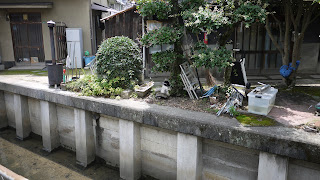Judging by all the little rice fields tucked here and there between houses and buildings, I always get the feeling that Fukuyama is just a country town that happened to get big. Houses in the older central neighbourhoods like ours seem to be built around the existing channels bringing water from the Ashida River to farmer's fields. There just happen to be way less of those fields now!
How do these ditches have any influence on our daily lives, you might ask? Well, firstly you must always pay attention to them when you are biking, especially when Theo is riding his bike. I have visions of him flying over the edge of one of the deeper, wetter ones and breaking his bike and landing himself in the hospital while he's at it. Theo has skinned his knee and lost two water bottles to the ditches on his way home from school. The streets in our neighbourhood are notoriously badly lit at night and I am surprised I haven't walked or ridden into one accidentally myself. With streets so insanely narrow, virtually no shoulder, and a 50 cm drop off on either side of the road, can you blame me for being a little hesitant about driving a car in Japan?
Secondly, the little piece of the street and the ditch that wraps around our house is considered our responsibility to keep clean and free of debris. I feel like every high schooler passing by decides this is the prime place to throw their empty drink boxes and ice cream wrappers and every smoker seems to think our ditch looks like an ideal ashtray. I also have to clean up leaves and toys that the boys throw over the fence, but I just don't have the same animosity toward our children as I do strangers littering in front of our house. Lowering myself down into a narrow, mossy, slick ditch to scrape up leaves, mud, and cigarette butts is very rarely my idea of a good time. Maybe that is why our ditch doesn't look as sparklingly clean and pristine as most of the obaasan's do?
 Lastly, the deeper ditches that have at least some water all year long are wonderful for watering plants. You don't need to waste water or money by filling up watering cans with a hose when you can just collect some of the water from the ditch next door. The water is not contaminated in any way, I wouldn't exactly brush my teeth with it, but it is more than okay to use it for plant watering. Since it is mostly rain and river water I think it is probably better for your plants than using the treated water from our taps. I was lucky enough to find and old but useable long handled dipper in the space underneath our house which came in really handy when we still had our community garden plot!
Lastly, the deeper ditches that have at least some water all year long are wonderful for watering plants. You don't need to waste water or money by filling up watering cans with a hose when you can just collect some of the water from the ditch next door. The water is not contaminated in any way, I wouldn't exactly brush my teeth with it, but it is more than okay to use it for plant watering. Since it is mostly rain and river water I think it is probably better for your plants than using the treated water from our taps. I was lucky enough to find and old but useable long handled dipper in the space underneath our house which came in really handy when we still had our community garden plot! 







3 comments:
It is a detail like this that makes your blog so great, Laura. Thank you for noticing the differences and rejoicing in them. It is just a ditch, but it is somehow other worldly to me. Thanks for the stories of another land.
We used to call those drains gaijin traps when I was there. My friend fell in one one night and hurt her leg really badly. She still has a scar
Haha, we actually call them gaijin traps too. We're not the only victims though. A Japanese friend of ours has driven her car over the edge numerous times and I saw an older Japanese gentleman just barely miss driving into one the other day. I bet everyone has a dangerous or nearly dangerous encounter with one of those ditches!
Post a Comment